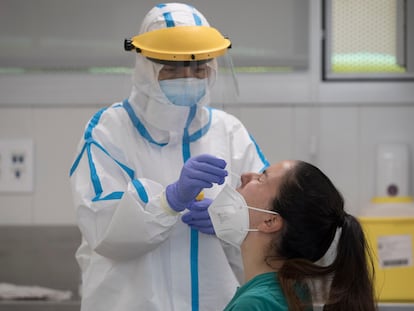Why does Italy have fewer new Covid-19 cases than Spain?
Since the Italian government eased lockdown restrictions, the country has been reporting an average of 200 daily infections, while Spanish authorities are recording more than 1,500
Italy was the mirror that Spain looked into during the coronavirus pandemic, as it provided an early image of the effects of the virus.
Italy introduced confinement measures earlier – on March 9 versus March 14 in Spain. It also has a higher official death count: 35,132 compared with 28,445 confirmed by the Spanish Health Ministry, although this newspaper has calculated that the real toll could be closer to 45,000.
But ever since Italy began lifting restrictions in late May, it has been posting figures suggesting that the pandemic is more in check there than in Spain, where cases are surging.
Recent data shows that there are 47 Covid-19 patients in Italian intensive care units, whereas there are 250 in Spain’s ICUs. Hospital admissions are significantly lower as well: 748 in Italy versus nearly 2,000 in Spain.
And in Italy, an average of 200 new cases are being reported daily, without any sudden surges, whereas Spain is seeing in excess of 1,500 new cases every 24 hours.
Imported cases
Despite the moderately good news, Italian authorities are insisting on the need to be prudent, as some parts of the country are still experiencing significant transmission. Imported cases are their main concern right now, as most of the outbreaks have been caused by foreign nationals coming into Italy.
When a new outbreak is identified in Italy, a quarantine is imposed on the building, the workplace and, if necessary, the entire neighborhood. Italy has also decided to maintain the obligation for self-isolation for all travelers from outside the EU and Schengen Area, and most recently it has added Romania and Bulgaria to the quarantine list. In response to a recent increase in cases among citizens of Bangladesh, arrivals from this country are now banned.
For now at least, the Italian government is not contemplating restrictions against travelers from Spain. But it is monitoring events there with concern.
Unlike Spain, where regional authorities reopened nightclubs and other nighttime venues weeks ago, Italy has postponed this move, which had originally been scheduled for late July. Now, Spanish authorities are considering whether to reintroduce restrictions on nightlife.
Italy has also extended the government’s emergency powers to October 15, partly due to concern over the situation in nearby countries such as France (1,377 new cases on Thursday) and Spain (3,092 new cases on Friday). “The virus is still circulating, the international situation requires us to be alert,” said Italy’s Prime Minister Giuseppe Conte.
Face masks
Italian virologists feel that the use of face masks may also be playing a role in containing the virus. According to statistics used by the scientific committee that is advising the government, around 85% of the population always wears a face covering, even if it is not mandatory. Those who fail to wear it in situations where it is compulsory face fines of up to €1,000, while infected individuals who break quarantine rules risk prison.
In Spain, all regions except for the Canary Islands have now made face masks compulsory in all public places, whether indoors or outdoors. Madrid was the last region to join the list.
But the scientific community is divided over the reasons behind Italy’s success story – or even whether this success story is real at all. Some specialists believe that not enough testing is being done to obtain a complete picture of the real situation, or at least that authorities are not looking in the right places.
“Perhaps we are not testing the right people,” noted the virologist Andrea Crisanti, one of Italy’s most respected experts. Crisanti is credited with managing to contain transmission in the Veneto region by recommending early extensive testing, even on people without symptoms, back when even the World Health Organization (WHO) was not recommending it. Crisanti now suggests that testing should be conducted among people who attend parties and other large gatherings where there is a lot of social interaction, sometimes without protection measures. He also recommends testing every passenger coming into Italy.
Some regional governors, such as Enrico Rossi of Toscana, have embraced the idea and are now suggesting massive testing campaigns in popular spots such as seaside resorts and other tourist hotspots.
English version by Susana Urra.
Tu suscripción se está usando en otro dispositivo
¿Quieres añadir otro usuario a tu suscripción?
Si continúas leyendo en este dispositivo, no se podrá leer en el otro.
FlechaTu suscripción se está usando en otro dispositivo y solo puedes acceder a EL PAÍS desde un dispositivo a la vez.
Si quieres compartir tu cuenta, cambia tu suscripción a la modalidad Premium, así podrás añadir otro usuario. Cada uno accederá con su propia cuenta de email, lo que os permitirá personalizar vuestra experiencia en EL PAÍS.
¿Tienes una suscripción de empresa? Accede aquí para contratar más cuentas.
En el caso de no saber quién está usando tu cuenta, te recomendamos cambiar tu contraseña aquí.
Si decides continuar compartiendo tu cuenta, este mensaje se mostrará en tu dispositivo y en el de la otra persona que está usando tu cuenta de forma indefinida, afectando a tu experiencia de lectura. Puedes consultar aquí los términos y condiciones de la suscripción digital.
More information
Últimas noticias
Raúl Rocha, from jet-setting with Miss Universe to arms trafficking and fuel theft
80,000 barrels of Mexican oil sent to Cuba: Havana drawn into the US–Mexico clash
Human rights activists, opposition members, and a minor: Maduro’s other political prisoners
Israel sparks a civil war within the MAGA movement
Most viewed
- Reinhard Genzel, Nobel laureate in physics: ‘One-minute videos will never give you the truth’
- Pablo Escobar’s hippos: A serious environmental problem, 40 years on
- Charles Dubouloz, mountaineering star, retires at 36 with a farewell tour inspired by Walter Bonatti
- Why we lost the habit of sleeping in two segments and how that changed our sense of time
- The fall of a prolific science journal exposes the billion-dollar profits of scientific publishing











































